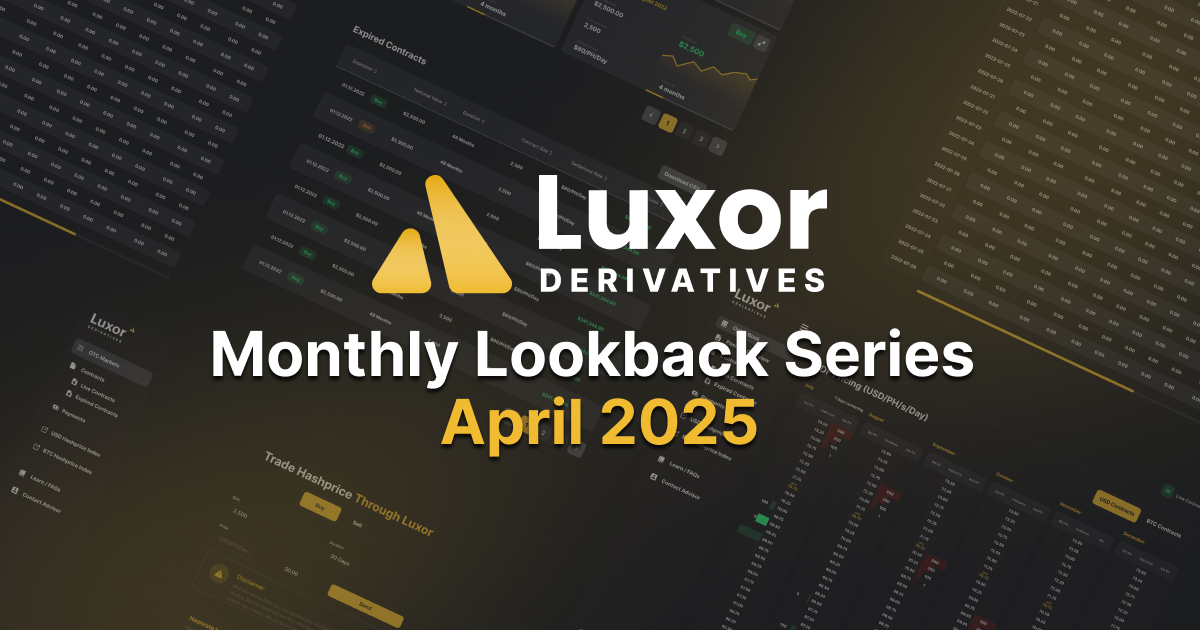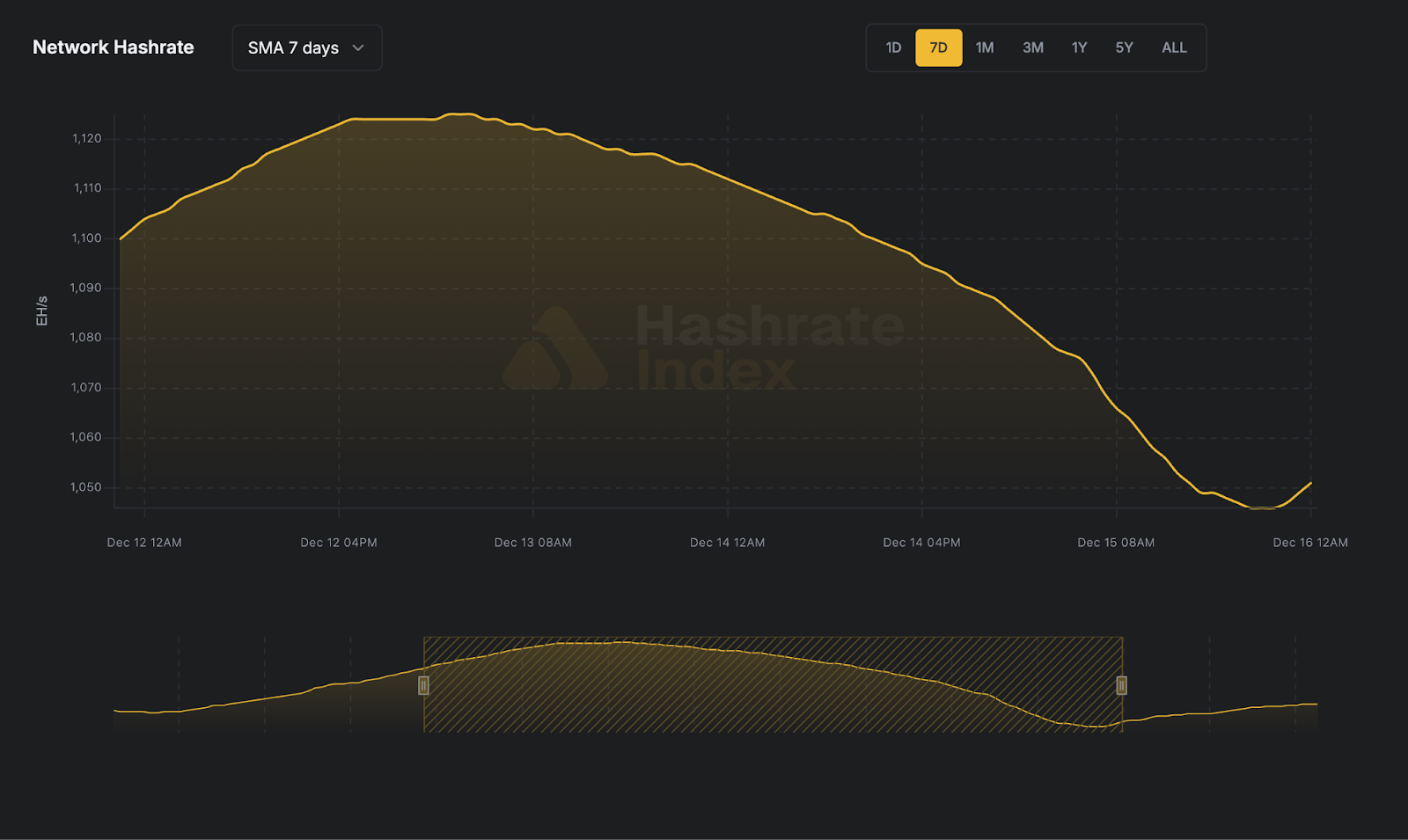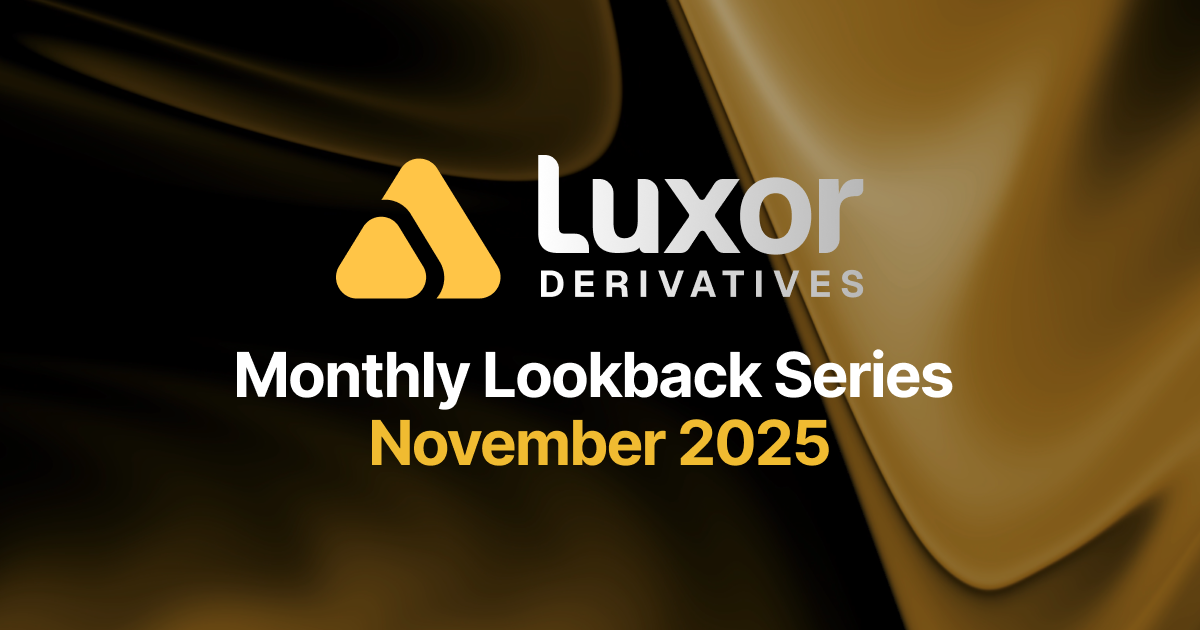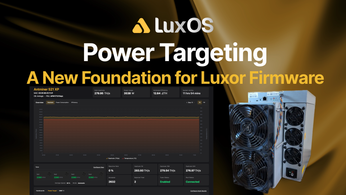
Luxor Hashrate Lookback Series - April 2025
April 2025’s hashrate and hashprice trends, forward market participation, trading activity and contract performance.
Luxor’s Monthly Lookback Series is a deep dive into Bitcoin hashrate market activity. In this post, we cover April 2025’s hashrate market and hashprice trends, forward market participation, trading activity and contract performance.
Summary
- April’s Ascent: Bitcoin mining conditions began under pressure but reversed and improved over the month. A sharp 12% Bitcoin price rally helped restore mining margins.
- Difficulty & Fees Up: Network difficulty increased 8.3% across two consecutive upward adjustments, setting a new all-time high monthly average of 120.98T. Meanwhile, transaction fees posted their first month-over-month gain since October 2024, rising 8.7% due to an isolated fee event.
- Sellers Take the Cake: Forward sellers outperformed spot mining across both BTC-denominated and USD-denominated markets, regardless of timing. USD contracts 1-3 months ahead delivered up to 26% more revenue, while BTC contracts locked in up to 9% more bitcoin production than spot.
April 2025 Spot Hashprice & Its Constituents
In April, Bitcoin mining markets started in decline but eventually surprised to the upside, closing off with a strong recovery.
Compared to March, the monthly average for network difficulty (i.e., hashrate) increased 7.9% to a new all time high. Bitcoin price remained relatively steady, with a slight rise of 1.5% month-over-month (MoM), driven by a price rally towards month-end. Similarly, transaction fee reward collection increased 8.7% (MoM), primarily due to Runes activity.
As a result, monthly averages for USD and BTC hashprice dropped 5.8% and 7.2%, respectively.
USD Hashprice entered April 2025 at $46.93 per PH/s/day, rising slightly to $48.93 by month-end. The intra-month range was $8.37, with low & high values of $40.71 & $49.08 observed on April 7 and April 29. Despite early weakness, USD hashprice later found support through bullish Bitcoin price action; the monthly average for USD hashprice settled at $45.46.
Bitcoin entered April at $84,047 and closed at $94,504, climbing over 12%. The intra-month range was $17,099, with low & high values of $77,774 & $94,873 observed on April 7 and April 29 (matching USD hashprice). The monthly average for Bitcoin price came in at $86,331.
The intra-month range for Bitcoin price in April reflects a high degree of volatility. The last time a range this large was observed was during November 2024, which was the post-election period that set the stage for Bitcoin breaking $100,000 shortly after.
Bitcoin price bottomed early in the month before a strong and steady recovery. The pullback was likely driven by ongoing concerns around inflation, trade wars, and geopolitical tensions, which has been pressuring risk assets across equity and Bitcoin markets since March. Notably, public mining equities led the decline, reflecting the cohort’s high-beta behaviour to Bitcoin and traditional equity markets.
In April, this global risk sentiment stemming from uncertainty continued but shifted sharply in the final 10 days. A softer-than-expected U.S. CPI print, and continued institutional inflows helped push Bitcoin price back above $94,000. The turnaround lifted both spot and forward hashprice, offering relief to miners facing compressed margins. Mining equities lagged the broader rebound as well, exhibiting the weakest recovery overall.
Network difficulty began April at 113.76T and ended at 123.23T, notching an overall 8.3% increase over the month. Two positive difficulty adjustments occurred: the first on April 5 and the second on April 19, increasing network difficulty by 6.81% and 1.42%, respectively. Overall, average difficulty was 120.98T in April, marking the highest average difficulty level on record.
Interestingly, Bitcoin’s network hashrate experienced a meaningful decline in the second half of April, leading to slow block times that pushed above the 10-minute target.
The 7-day simple moving average (7D SMA) for network hashrate began April at 833 EH/s and ended the month just slightly higher at 850 EH/s, a 1.94% increase. However, the intra-month range was 103 EH/s, with high & low values of 924 EH/s & 820 EH/s observed on April 9th & April 28th. Overall, the monthly average for the 7-day network hashrate was 874 EH/s.
While the net change in hashrate was modest, the intra-month range was significant and reflected on block production. Based on block time observations, we estimate that approximately 95 EH/s dropped off the network between April 18 - April 25, a 10% decline. As shown below, daily average block times exceeded the 10-minute target across 6 of the final 10 days of April, confirming that a significant number of miners probably went offline (or underclocked, or had extremely bad luck).
Transaction fee rewards began the month at a daily average of 0.032 BTC (per block) and ended at 0.050 BTC, representing a 54.9% increase over the month. The intra-month range was 0.074 BTC, with low & high values of 0.025 BTC & 0.099 BTC observed on April 13 and April 23. Overall, the monthly average fee level was 0.042 BTC, an 8.7% increase (MoM).
A notable spike in fee collection occurred on April 23, which was driven by an isolated fee event: the “Alkanes” mint. Although brief, it lifted the monthly average fee level by 5 percentage points, contributing to the hashprice relief toward month-end. In USD terms, average transaction fee collection per block in April was $3,684, an 11% increase (MoM). Overall, transaction fees constituted 1.34% of total block rewards.
BTC hashprice entered April at 0.00056 BTC per PH/s/day and declined to 0.00052 BTC by month-end, a 7.3% drop over the month. The intra-month range was 0.00004 BTC, with high & low values of 0.00056 BTC & 0.00052 BTC observed on April 4 and April 27. The monthly average for BTC hashprice settled at 0.00053 BTC.
The downward drift in BTC hashprice was largely driven by the increase in network difficulty over the month, which more than offset any modest gains in transaction fees.
From an Energy Hashprice (i.e., revenue-per-watt) perspective, operations with sub-19 J/TH fleets are currently earning over $110 per MWh, whereas miners in the 19-25 J/TH and 25-38 J/TH categories are earning anywhere between $90 and $60, respectively.
April 2025 Hashrate Market Activity
Our analysis of the April hashrate market focuses on two key points: how the April 2025 hashrate contract traded in previous months and how the forward curve shifted in April, based on pricing for forward hashrate during the month.
The two tables below show the evolution of USD and BTC denominated Bitcoin hashrate forward markets from November 2024 - April 2025. Rows represent specific monthly contracts, while columns represent each trading month. Cell values indicate the average monthly mid-market price — except for the bold highlighted main diagonal — which shows actual spot hashprice settlement in each month.
This table summarizes both the trading history of the April 2025 contract (colored row) and the forward curve in April (colored column).
Note: all values shown in figures represent the midpoint of the best bid and ask on Luxor's Non-Deliverable Hashprice Forward market.
The table below shows the type of market participants on the buy and sell side of Luxor’s deliverable (DF) and non-deliverable hashrate forward (NDF) market. In April, lenders were active on the buy side of the DF market, while public and private miners used the contract to sell forward, receive financing, and expand their fleet.
Since the DF involves upfront payment, it tends to trade at a discount to the NDF (compensating the buyer for the inherent credit risk). We see the discount of DF’s relative to NDF’s as the interest rate in hashrate-based lending markets. Buyers and sellers of the DF with upfront payment can use the NDF to lock-in a fixed yield or cost of capital instead of having exposure to hashprice uncertainty.
This strategy was used by lenders (i.e., buy the DF & sell the NDF) to earn a return and by miners (i.e., sell the DF & buy the NDF) to obtain non-dilutive financing. In April 2025, that yield or cost of capital was in the 8-13% (annualized) range.
How April 2025 Hashrate Traded
April's forward hashrate market saw a clear trend: sellers won across the board. USD and BTC denominated hashrate markets both saw similar outcomes, regardless of timing.
In USD denominated markets, the April 2025 contract settled at $45.46 per PH/s/day. This was consistently lower than contract settlements throughout November 2024 - March 2025, which ranged between $51.15 - $49.89. As a result, hedging miners (sellers) were able to lock in more favorable pool payout rates and outperform spot (FPPS) mining. Conversely, long positions (buyers) lost, having paid a higher forward hashprice versus what they would have ultimately realized in the spot market.
In BTC denominated markets, the April 2025 contract settled at 0.00053 BTC per PH/s/day. Once again, this was also lower than contract settlements throughout November 2024 - March 2025, which ranged between 0.00056 BTC - 0.00058 BTC. As a result, hedgers (sellers) won by locking in a higher BTC denominated hashprice versus spot.
The table below summarizes how a 1 EH mining operation’s USD revenues would have performed against spot mining, had it sold April 2025 hashrate forward:
For sellers, selling April 2025 hashrate in advance outperformed spot mining but varied significantly based on timing. Miners who sold forward 5 months ahead (November 2024) outperformed by 13%, whereas those who sold forward closer to April (December 2024 - February 2025) captured between 18-26% more USD revenue. Even miners who sold forward just 1 month in advance improved their cash flow by 10%, highlighting the value of consistent forward sales (i.e., a rolling hedge) in a declining hashprice environment.
For buyers, purchasing April 2025 hashrate in advance meant paying more than the actual realized hashprice. Buyers lost across the board.
In hindsight, the optimal seller’s trade for the April 2025 USD contract was 3 months out, i.e., selling April’s hashrate forward in January (when Bitcoin was at or near all time highs), and locking in a $57.08 hashprice. For a 1EH mining operation, this would have resulted in an additional $348,745 in revenue, a 26% increase.
The table below summarizes how a 1 EH mining operation’s total bitcoin production would have performed against spot mining, had it sold April 2025 hashrate forward:
The magnitude of outperformance was smaller in the BTC denominated forward market versus its USD counterpart but still favorable to sellers across all durations.
For sellers, performance results were modestly positive. Selling April 2025 hashrate in BTC terms 1-5 months ahead delivered 4-9% more total BTC than spot mining.
For buyers, once again, purchasing April 2025 hashrate in advance meant paying more than the actual realized hashprice. However, BTC denominated forward hashrate buyers weren’t dramatically mispricing the market, overpaying by 4-6%, which is a relatively tight spread between forward and actual hashprice when compared to the USD denominated market.
In hindsight, the optimal seller’s trade for the April 2025 BTC contract was 1 month out, i.e., selling April’s hashrate forward in March and locking in a 0.00058 BTC hashprice. For a 1EH mining operation, this would have resulted in an additional 1.45 BTC in earnings, a 9% increase.
Most public mining companies did not hedge Bitcoin production in April 2025. The chart below illustrates a hypothetical scenario of how public miners' April 2025 Bitcoin production would have differed if they had fully hedged their production back in November 2024:
Zooming out, the following chart reveals how different rolling hedge strategies performed relative to spot mining, segmented by contract denomination and hedge horizon, from May 2024 – April 2025:
This comparison highlights a clear outperformance of rolling BTC denominated hedging between May 2024 - April 2025. Longer-duration BTC denominated forward selling strategies, particularly the 5 and 4-month durations, delivered the strongest results. These strategies benefited from contracts being priced ahead of rising network difficulty & underwhelming transaction fees, in addition to maintaining Bitcoin price exposure. In contrast, USD denominated hedging generally underperformed, with losses increasing the further out the hedge was placed.
Note: these figures are strictly for demonstration purposes and exclude fees and bid/ask spreads associated with entering into hashrate forward contracts.
A second caveat: although selling forward proved to be favorable during timeframes shown above, it is critical to recognize that hedging is typically a cost of business rather than a revenue generation method. Hedgers willingly pay a price to buy certainty and obtain more predictable cash flows, which increases valuation, reduces cost of capital, and ultimately attracts investments.
How Future Hashrate Traded in April 2025
The two tables below summarize the evolution of hashrate forward markets during April 2025, for the subsequent five months from May 2025 - September 2025. Rows represent specific monthly hashrate contracts, while columns represent specific trading days. Cell values indicate the average daily mid-market price, except for spot prices.
During April trading, The USD denominated forward curve saw strong upward momentum, mirroring spot markets.
On April 7, May 2025 - September 2025 contracts traded between $41.88 - $40.50, with the latter end of the curve in mild backwardation compared to prevailing spot hashprice ($41.42) at the time. However, as the month progressed and spot hashprice jumped up to $48.90 by April 28, forward prices followed suit. By the end of the month, contracts for May through September had repriced higher, all trading near $50 or above.
The BTC denominated forward curve also showed mild backwardation at the start of the month, with further out contracts (August 2025 - September 2025) pricing around 0.00050 BTC - 0.00051 BTC, below the spot level of 0.00052 BTC at the time. Later in the month, the front-end of the curve rose to 0.00055 BTC as spot hashprice improved. However, the back-end contracts (July-September) did not meaningfully reprice upward and remained near 0.00051 BTC - 0.00052 BTC.
This suggests that forward market participants priced in a negative adjustment for early May, while maintaining status-quo expectations for the medium-term. As block times slowed and hashrate fell between April 20 - April 30, forward market participants began incorporating negative difficulty adjustment forecasts into their decisions, which is most clearly seen in forward BTC denominated hashprice. Although the actual adjustment ended up being smaller in magnitude, the front-end movement in the BTC denominated curve demonstrated the market anticipating it.
By dividing USD contract values with BTC contract values, we can use the two contracts to back out implied Bitcoin price expectations expressed by the forward market. Throughout April, implied Bitcoin price expectations rose steadily, mirroring the rally in spot markets and indicating renewed bullish sentiment for the near future.
At the start of the month on April 7, spot BTC price was $79,654, and forward implied prices for May 2025 - September 2025 ranged narrowly between $78,846 and $81,000, reflecting a relatively muted outlook. However, as spot BTC recovered sharply — hitting $94,038 by April 28 — implied prices were revised up, most notably in further out contracts (August 2025 - September 2025), signaling a medium-term outlook of confidence in Bitcoin price upside.
If we make an assumption around transaction fees, we can also calculate the changes in implied difficulty and network hashrate expectations expressed by the forward market. In the tables below, we assume a 0.04 BTC and 0.03 BTC per block transaction fee collection on April 7th and May 5th, respectively:
Note: figures assume 0.04 BTC and 0.03 BTC per block transaction fee collection on April 7th and May 5th, 2025.
Based on this simplified analysis, we estimate that future hashrate expectations remained stable during the month of April, changing in the 0-2% range for the May 2025 - September 2025 contracts.
Concluding Thoughts and Looking Ahead
Since the April 2024 halving, Bitcoin price has outperformed expectations, whereas mining markets have trailed behind. Throughout this period, miners who were hedged against network difficulty and transaction fees ended up outperforming their peers. By locking in fixed pool payouts, hedged miners effectively mitigated the subsequent hashprice decline. Operators who took advantage of upfront payouts did even better.
For miners facing rising hardware costs and tighter margins, locking in predictable cash flow becomes increasingly valuable. Selling hashrate forward enables miners to hedge against uncertainty, offering protection from both policy-driven shocks and mining market fundamentals.
As mentioned in our previous Monthly Lookback, the transition to milder weather marks the start of ERCOT’s 4CP Program cycle, a period where strategic curtailment becomes critical for Texan miners. However, 4CP is only one part of the broader energy playbook.
The chart below captures a different, yet equally important dynamic: economic curtailment driven by volatile intraday power prices.
Spot vs. Fixed Price vs. Partial PPA: Mining Revenue, Costs & Net Profit
This snapshot reveals some insight on how a miner may consider building a hedge profile based on its risk appetite, operating model, and market view.
If you are interested in learning more about mining and energy, check out our recently launched series: Energy Markets for Bitcoin Miners.
In the next few posts for this series, we’ll explore advanced strategies miners are using to deepen their exposure to power markets — and how to create value beyond producing Bitcoin.
Looking forward, Luxor’s Hashrate Forward Market is pricing in an average hashprice of $51.71 or 0.00049 BTC per PH/s/day over the next six months. Sellers can currently secure this hashprice while buyers have the opportunity to lock in the same hashcost through to October 2025.
If you’d like to learn more about Luxor’s Bitcoin mining derivatives, please reach out to [email protected] or visit https://www.luxor.tech/derivatives.
Disclaimer
This content is for informational purposes only, you should not construe any such information or other material as legal, investment, financial, or other advice. Nothing contained in our content constitutes a solicitation, recommendation, endorsement, or offer by Luxor or any of Luxor’s employees to buy or sell any derivatives or other financial instruments in this or in any other jurisdiction in which such solicitation or offer would be unlawful under the derivatives laws of such jurisdiction.
There are risks associated with trading derivatives. Trading in derivatives involves risk of loss, loss of principal is possible.
Hashrate Index Newsletter
Join the newsletter to receive the latest updates in your inbox.









